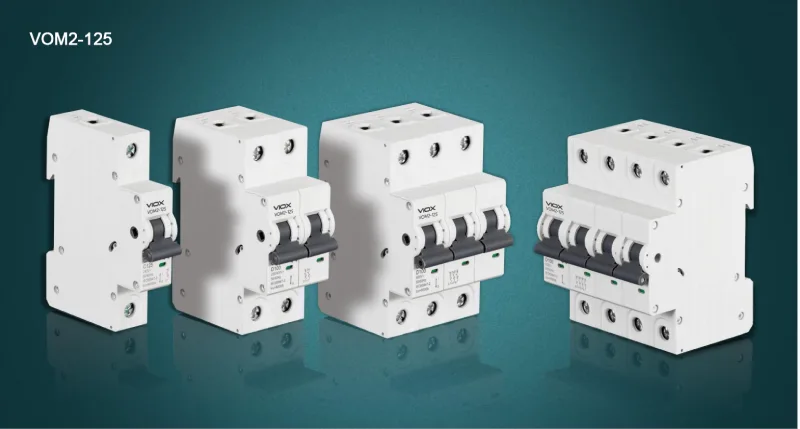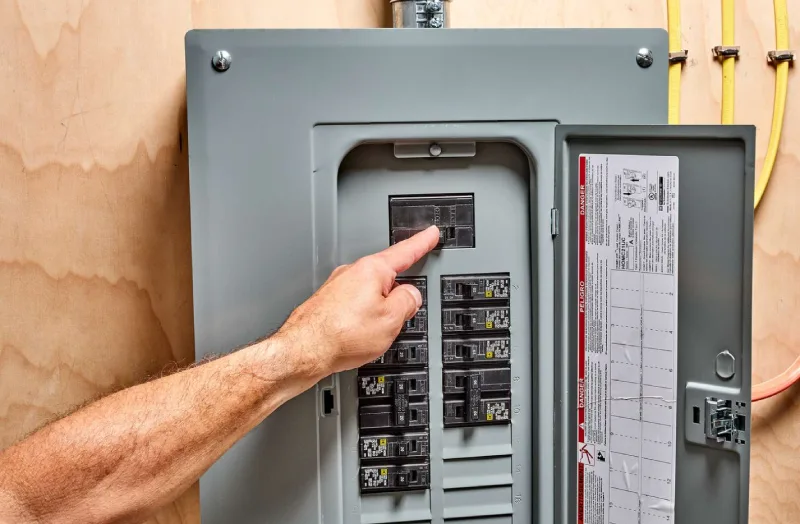Neposreden odgovor: MCBs (Miniature Circuit Breakers) don’t mention short circuit making current because they’re designed with inherent making capacity that exceeds their breaking capacity by a standard factor of 2.1 to 2.2, as mandated by IEC 60898 standards. This built-in safety margin means manufacturers only need to specify the breaking capacity (Ics/Icu), as the making capacity is automatically guaranteed to handle the asymmetrical fault currents during circuit closure.

Understanding MCB Making Current vs Breaking Current
When you’re selecting MCBs for your electrical installation, you’ll notice specifications list breaking capacity but mysteriously omit making current ratings. This isn’t an oversight—it’s intentional engineering design that simplifies selection while ensuring safety.
What Makes Making Current Different from Breaking Current
Making current refers to the maximum peak current an MCB can safely handle when closing onto an existing fault. During this critical moment, the current can reach 2.1 to 2.2 times the RMS breaking current due to DC component asymmetry.
Breaking current represents the maximum fault current the MCB can safely interrupt and clear from the circuit. This is what you see printed on every MCB as Ics (service breaking capacity) or Icu (ultimate breaking capacity).
Key Differences Between Making and Breaking Operations
| Značilnost | Making Operation | Breaking Operation |
|---|---|---|
| Trenutna magnituda | 2.1-2.2 × RMS value | RMS symmetrical value |
| DC Component | Maximum (100%) | Varies (0-100%) |
| Contact Stress | Electromagnetic repulsion | Arc erosion |
| Trajanje | Instantaneous (<10ms) | 10-20ms typical |
| Critical Factor | Mechanical withstand | Izumiranje loka |
| Design Priority | Robust contacts | Arc chute efficiency |
| Standardna referenca | IEC 60898-1 Clause 9.12.11 | IEC 60898-1 Clause 9.12 |

Why MCB Manufacturers Don’t Specify Making Current
1. Built-in Safety Factor
MCBs are manufactured with making capacity automatically sized at 2.2 times their breaking capacity. When you select an MCB with 10kA breaking capacity, you’re guaranteed it can make onto a fault current of 22kA peak.
2. International Standard Requirements
IEC 60898-1 mandates that all MCBs must withstand making current at the prescribed ratio. Manufacturers cannot produce compliant MCBs without this capability, making separate specification redundant.
3. Simplified Selection Process
By focusing on breaking capacity alone, you can select MCBs based on prospective fault current calculations without complex asymmetry factor calculations.
Nasvet strokovnjaka: Always verify your installation’s prospective fault current using proper testing equipment. The breaking capacity must exceed this value with appropriate safety margin.
MCB Rating Classifications and Making Capacity
| Breaking Capacity (Ics/Icu) | Automatic Making Capacity | Tipične aplikacije |
|---|---|---|
| 3 kA | 6.6 kA peak | Residential final circuits |
| 4.5 kA | 9.9 kA peak | Light commercial circuits |
| 6 kA | 13.2 kA peak | Standard commercial/industrial |
| 10 kA | 22 kA peak | Heavy industrial/near transformer |
| 15 kA | 33 kA peak | Main distribution boards |
| 25 kA | 55 kA peak | Industrial switchboards |

Applications Where Making Current Matters Most
Near Transformer Installations
You need higher breaking capacity MCBs when installing circuits close to transformers where fault currents are maximum. The making capacity becomes critical during:
- Restoration after outages
- Manual circuit energization
- Automatic reclosing operations
Industrial Motor Circuits
Large motor circuits present unique challenges with high inrush currents. While not fault currents, these can approach making current levels during:
- Direct-on-line starting
- Star-delta transition
- Auto-transformer starting
Parallel Supply Systems
When multiple transformers or generators operate in parallel, fault currents increase significantly. Making capacity ensures safe manual operation even under worst-case fault conditions.
⚠️ Varnostno opozorilo: Never attempt to close an MCB manually if you suspect a fault condition exists. Always perform insulation resistance testing before energizing circuits.

How to Select MCBs Without Making Current Specifications
Step 1: Calculate Prospective Fault Current
Determine your installation’s maximum prospective short circuit current (Ipf) at the MCB location using:
- Impedance calculations
- Testing instruments
- Utility-provided data
Step 2: Apply Safety Factor
Select MCB breaking capacity at least 1.2 times your calculated Ipf for reliability and future system changes.
Step 3: Verify Discrimination
Ensure proper coordination with upstream and downstream protective devices using time-current curves.
Step 4: Consider Environmental Factors
Adjust ratings for:
- Ambient temperature (derating above 30°C)
- Altitude (derating above 2000m)
- Grouping factors for multiple MCBs
Step 5: Check Compliance
Verify selected MCBs meet local electrical codes and standards:
- IEC 60898 for international applications
- UL 489 for North American installations
- AS/NZS 60898 for Australian/New Zealand
Common Misconceptions About MCB Making Current
Misconception 1: “Higher Breaking Capacity Always Better”
Resničnost: Oversizing breaking capacity can compromise discrimination and increase costs unnecessarily. Select based on actual fault current calculations.
Misconception 2: “Making Current Equals Inrush Current”
Resničnost: Making current refers to fault conditions, while inrush current occurs during normal equipment energization.
Misconception 3: “All MCBs Have Same Making/Breaking Ratio”
Resničnost: While IEC standards specify minimum ratios, premium MCBs may exceed these requirements.
Najboljše prakse profesionalne namestitve
Pre-Installation Verification
- Confirm prospective fault current measurements
- Verify MCB ratings match design specifications
- Check for proper torque specifications
During Installation
- Use calibrated torque wrenches for connections
- Maintain proper phase spacing
- Install appropriate arc containment barriers
Testiranje po namestitvi
- Perform insulation resistance testing
- Verify trip characteristics using injection testing
- Document all test results for compliance
Nasvet strokovnjaka: Modern MCB designs incorporate current-limiting technology that reduces both making and breaking stress, extending operational life beyond standard requirements.
Quick Reference Guide: MCB Selection Without Making Current Data
For Residential Installations:
- Final circuits: 6kA breaking capacity minimum
- Distribution boards: 10kA typical
- Main switches: Based on utility fault level
For Commercial Installations:
- Lighting circuits: 6-10kA
- Power circuits: 10-15kA
- Main distribution: 15-25kA
Za industrijsko uporabo:
- Control circuits: 10kA minimum
- Motor circuits: 15-25kA
- Main switchboards: 25-50kA
FAQ: MCB Making Current Questions
What should you look for when MCB making current isn’t specified?
Look for the breaking capacity (Ics or Icu) rating, which automatically ensures adequate making capacity per IEC standards. The making capacity will be 2.1-2.2 times this value.
How does making current affect MCB selection for solar installations?
Solar installations require MCBs rated for DC applications with appropriate breaking capacity for maximum system fault current. DC making current considerations are more critical due to absence of natural current zeros.
Why do some industrial MCBs mention making capacity separately?
Specialty industrial MCBs, particularly those above 100A or with enhanced breaking capacity, may list making capacity when it exceeds standard ratios for marketing differentiation.
Can an MCB make onto a fault current higher than its breaking capacity?
Yes, an MCB can momentarily withstand making current up to 2.2 times its breaking capacity, but it may not successfully break the circuit, potentially causing catastrophic failure.
What’s the difference between MCB and MCCB making current specifications?
MCCBs (Molded Case Circuit Breakers) often specify making capacity separately because they serve higher current applications where the standard ratio may not apply uniformly.
Should you consider making current when coordinating protection devices?
While making current doesn’t directly affect discrimination, understanding fault current asymmetry helps ensure proper coordination during worst-case scenarios.
How do modern MCBs handle making current without damage?
Advanced contact materials, optimized contact geometry, and magnetic blow-out systems help modern MCBs withstand making current stresses while maintaining long operational life.
What happens if an MCB’s making capacity is exceeded?
Exceeding making capacity can cause contact welding, mechanical damage, or explosive failure. This is why proper fault current assessment is critical for safety.
Conclusion: Understanding MCB Making Current for Safer Installations
MCBs don’t mention short circuit making current because international standards ensure every compliant MCB has making capacity of 2.1-2.2 times its stated breaking capacity. This standardization simplifies selection while maintaining safety margins for worst-case fault conditions.
When you select MCBs based on breaking capacity that exceeds your calculated prospective fault current, you’re automatically ensuring adequate making capacity. Focus on accurate fault current assessment, proper coordination, and compliance with local electrical codes for safe, reliable installations.
Povezano
Kaj je miniaturni odklopnik (MCB): Popoln vodnik za varnost in izbiro


